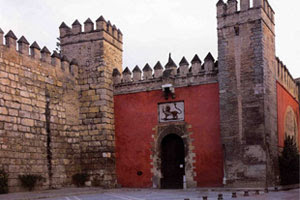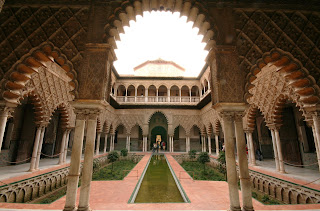 is a set palatal made between the tenth and twenty-first century and in the latter twentieth century in the various restorations have been made on the historic site on which areas of the palace have discovered that they were hidden.
is a set palatal made between the tenth and twenty-first century and in the latter twentieth century in the various restorations have been made on the historic site on which areas of the palace have discovered that they were hidden.  start talking about the Muslim era, which was ordered built by Abderrahman III , between 913 and 914 on the ruins of an ancient basilica, as the Governor's House which still has what today is the Patio de Banderas and his former wicket today walled.
start talking about the Muslim era, which was ordered built by Abderrahman III , between 913 and 914 on the ruins of an ancient basilica, as the Governor's House which still has what today is the Patio de Banderas and his former wicket today walled.  Already in the eleventh century the room was small, its walls were extended to what today is the Puerta de Jerez, the new palace was renamed Al-Muwarak meaning "the Fortress the blessing "of this reform we can highlight the Throne Room , cubic enclosure covered by a dome, this is what today is known as the Hall of Ambassadors .
Already in the eleventh century the room was small, its walls were extended to what today is the Puerta de Jerez, the new palace was renamed Al-Muwarak meaning "the Fortress the blessing "of this reform we can highlight the Throne Room , cubic enclosure covered by a dome, this is what today is known as the Hall of Ambassadors . In the twelfth century with the new reforms can meet what we know today as Baños de Doña María de Padilla and Patio del Yeso.
 Now with the conquest of Seville by Ferdinand III, King died in the Muslim palace, his son Alfonso X chose Seville as the capital of the kingdom and because of this made new reforms to welcome the court and also by one of his successors Pedro I such as the Fourth of Caracol , known today Cruise Garden, the Salons Carlos V the Garden Maria de Padilla, the courtroom and Mudejar Palace or Don Pedro .
Now with the conquest of Seville by Ferdinand III, King died in the Muslim palace, his son Alfonso X chose Seville as the capital of the kingdom and because of this made new reforms to welcome the court and also by one of his successors Pedro I such as the Fourth of Caracol , known today Cruise Garden, the Salons Carlos V the Garden Maria de Padilla, the courtroom and Mudejar Palace or Don Pedro .  Today the Palace has new gardens, has taken on other functions and uses that are not functions of the palace, is an extension of the Town Hall and the city's cultural forum, but all of these functions stands tourist monument reason since December 1987 is Heritage declared by Unesco.
Today the Palace has new gardens, has taken on other functions and uses that are not functions of the palace, is an extension of the Town Hall and the city's cultural forum, but all of these functions stands tourist monument reason since December 1987 is Heritage declared by Unesco.  Among the activities and the use that is given to the palace are to host the exhibition, early music summer concerts, theatrical performances and lectures.
Among the activities and the use that is given to the palace are to host the exhibition, early music summer concerts, theatrical performances and lectures.
 I personally would emphasize above all, apart from all the rooms already mentioned, the beautiful and relaxing gardens of the Alcazar where we can highlight the Pond Mercury with railing balusters (each one of the columns that make up the rails rails) and Gallery of the Grotesque (motif whimsical way of bugs, vermin, chimeras and foliage) the Garden of Lady the gazebo Carlos V and the always fun made hedge maze.
I personally would emphasize above all, apart from all the rooms already mentioned, the beautiful and relaxing gardens of the Alcazar where we can highlight the Pond Mercury with railing balusters (each one of the columns that make up the rails rails) and Gallery of the Grotesque (motif whimsical way of bugs, vermin, chimeras and foliage) the Garden of Lady the gazebo Carlos V and the always fun made hedge maze.

0 comments:
Post a Comment